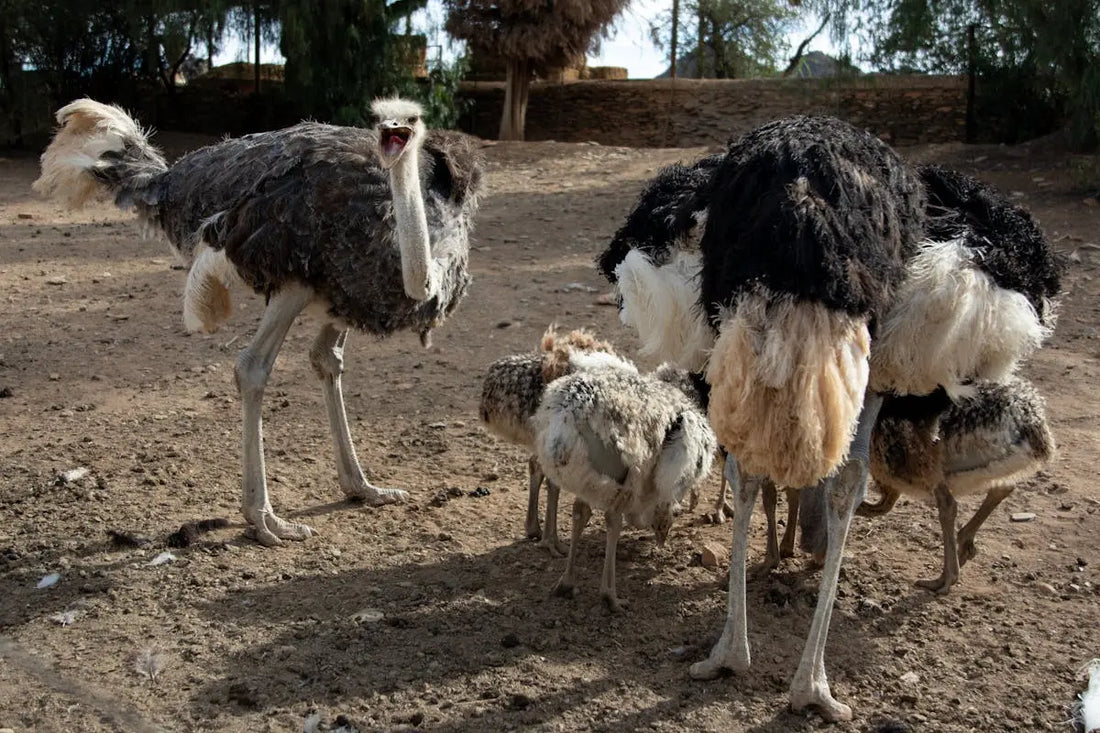
Breeding Ostriches: Essential Tips for Success
Share
The world of ostrich breeding can be both fascinating and challenging. With a little research, diligence, and attention to detail, you can turn this intriguing venture into a rewarding experience. In this blog, we’ll walk you through the essentials of ostrich breeding, breaking down complex information into simple steps to ensure you’re well-prepared for taking on ostrich.
Understanding Ostrich Breeding Basics
At the heart of ostrich farming is a deep understanding of their breeding habits and environments. Ostriches are intrinsically fascinating creatures, not just because they are the world’s largest birds but also because of their unique breeding behaviors. Males are polygamous and can have multiple female partners, which lay their eggs in a selective nests. The ostrich breeding season is subject to climate and geographical location factors. Identifying your area’s breeding season is critical to monitor and ensure the best results in chick production.
A key aspect of ostrich breeding is selecting the right pair or group. It’s proven that genetic diversity plays a crucial role in the health and viability of offspring. We emphasize the importance of genetic diversity in our breeding programs, ensuring a vibrant and resilient flock.
Ostriches engage in elaborate courtship displays, which include dancing, feather displays, and vocalizations. Understanding and facilitating an environment that accommodates these natural behaviors is crucial for successful breeding.
Choosing the Right Breeding Pair
The choice of breeding pairs is a calculated decision that impacts not only the immediate breeding season but the future genetic diversity and health of your flock. It involves assessing the health, genetics, and compatibility of potential pairs. Ideally, a breeding pair should be unrelated to prevent inbreeding, a practice that can lead to a higher susceptibility to disease and genetic anomalies.
Ostrich farmers must also consider the physical attributes and temperament of their breeding birds. Traits such as size, feather quality, and behavior play a significant role in the selection process, aiming to produce offspring that inherit the best qualities of their parents.
Creating the Ideal Breeding Environment
Crafting the perfect habitat for ostrich breeding involves mimicking their natural environment as closely as possible. This includes providing spacious enclosures that allow for the ostriches’ natural behaviors such as running and mating dances, adequate shelter from extreme weather conditions, and a diet that mirrors the nutritional variety they would find in the wild. The setup must also allow for easy monitoring and maintenance without causing stress to the animals.
Safety is paramount in the breeding enclosure, as is the management of vegetation, to prevent predators and ensure the health of the ostriches. Water sources should be clean and accessible, mimicking the watering holes ostriches might find in their natural savanna habitats.
Feeding and Nutrition for Breeding Ostriches
Nutrition plays a pivotal role in the health and fertility of ostriches. A balanced diet rich in protein, vitamins, and minerals is essential, particularly during the breeding season when the demands on the birds’ bodies are greatest. This not only affects the health of the breeding birds but also the vitality of the chicks they produce.
It’s crucial to provide a variety in their diet, incorporating both feed and natural foraging options to mirror the ostrich’s omnivorous diet in the wild. This includes seeds, shrubs, insects, and small lizards, providing both nutrition and behavioral enrichment.
Monitoring Health and Preventing Diseases in Ostriches
Regular health checks are vital to ensure the well-being of breeding ostriches. This includes monitoring for signs of stress or illness and providing supplements and parasite control as needed. A healthy flock is the foundation of a successful breeding program.
Disease prevention in ostrich farming cannot be overstated. Good hygiene practices, biosecurity measures, and proactive health management play crucial roles in minimizing the risk of disease outbreaks, which can devastate an entire breeding season’s efforts.
Managing Eggs and Incubation
Once the eggs are laid, careful handling and the right incubation conditions are crucial for maximizing hatch rates. The incubation period for ostrich eggs is approximately 39-42 days. During this time, maintaining stable temperature and humidity levels in the incubator is essential.
Egg rotation is another important aspect of the incubation process, simulating the natural turning by the parents in the wild. This ensures even development and temperature distribution within the egg. Monitoring development through candling can also inform the health and viability of the embryos.
Caring for Ostrich Chicks
The first few months of an ostrich chick’s life are critical. They require a warm, safe environment free from predators and the elements, as well as a nutritious diet that promotes healthy growth. Close monitoring for any signs of distress or illness is essential for early intervention.
As they grow, providing opportunities for exercise and exploration helps in the development of strong bones and muscles. Socialization with other chicks and gradual introduction to the adult flock will prepare them for integration into the larger group.
Common Challenges in Ostrich Breeding
Breeding ostriches is not without its challenges, including managing the territorial behavior of males, ensuring the fertility of eggs, and preventing diseases. Each of these areas requires careful attention and management to maintain a productive breeding program.
Environmental factors such as extreme weather conditions also pose challenges to breeding success. Adequate preparation and infrastructure can mitigate these risks and protect the flock from harm.
Launching Your Ostrich Breeding Adventure
The journey of ostrich breeding is extraordinarily complex, but undeniably rewarding. Throughout this guide, we’ve simplified the intricate details of the breeding process, from choosing the right breeding pair to ensuring the health and safety of your chicks. It’s a path that requires patience, dedication, and a deep understanding of these magnificent birds. With these tips and insights, you’re now equipped to start your very own ostrich breeding adventure. Remember, every step you take contributes to the conservation and appreciation of these extraordinary creatures. Ready to start your journey in ostrich farming? Visit superiorostrich.com to learn more and get started today!
